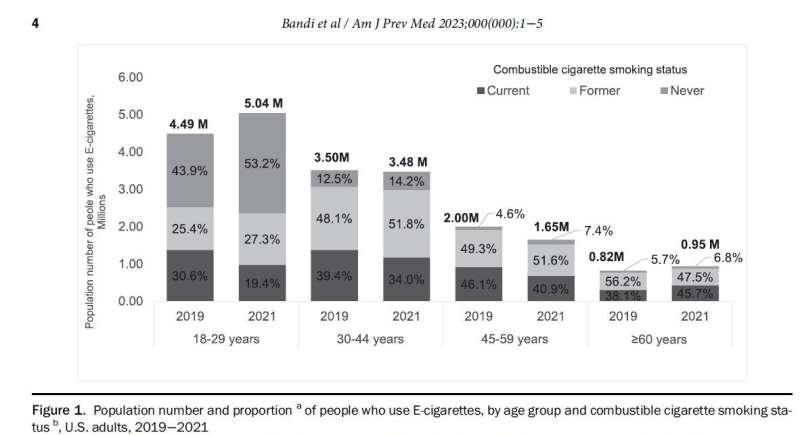
A new study by researchers at the American Cancer Society (ACS) shows almost three-quarters of a million more adults in the United States, ages 18-29 years, used e-cigarettes between 2019-2021 during the period that spanned the EVALI outbreak (E-cigarette or vaping product use–associated lung injury) and COVID-19 pandemic. Scientists report the year-on-year increase was primarily among adults who never smoked cigarettes. The study was published today in the American Journal of Preventive Medicine (AJPM).
“Unfortunately, these numbers show we’re moving in the wrong direction concerning e-cigarette use in this vulnerable population,” said Dr. Priti Bandi, scientific director, cancer risk factors & screening surveillance research at the American Cancer Society and lead author of the study.
“Our research finding is concerning as it may point to an increase in nicotine addiction risk for young adults, potentially contributing to progression to combustible tobacco products, and may also increase exposure to unknown toxicants, carcinogens, and the risk of respiratory diseases.”
Researchers pooled data from the National Health Interview Survey from 2019, 2020, and 2021 to estimate current e-cigarette use prevalence, adjusted prevalence difference between survey years, and population counts, by age group and cigarette smoking status (persons who currently, formerly, or never smoked).
The study results showed between 2019 and 2021, e-cigarette use prevalence increased from 8.8% in 2019 to 10.2% in 2021 among younger U.S. adults ages 18-29 years. Of note, among those young adults who never smoked cigarettes, e-cigarette use jumped from 4.9% in 2019 to 5.2% in 2020 to 6.4% in 2021. This group of young adults constituted 53% (2.68 million) of younger adults who used e-cigarettes in 2021, increasing by 0.71 million persons from 2019.
The study also showed among middle-aged and older U.S. adults, e-cigarette prevalence was similar in 2019 and 2021 irrespective of combustible cigarette smoking status. People who formerly smoked cigarettes constituted the largest population proportion of people who use e-cigarettes among adults older than 30 years in 2021 (51.1%, 3.1 million).
“E-cigarette use is not harmless at any age. It may have serious health risks, including negative short-term effects on airways and blood vessels, and we do not know the long-term effects of their use,” Bandi said. “We must address the rise in e-cigarette use among younger adults who never smoked cigarettes and, at the same time, help those who may have switched from cigarettes to e-cigarettes to stop using these devices completely.”
“It’s clear Big Tobacco’s strategy is to addict future generations to its products with e-cigarettes, putting the health of the country at risk,” said Lisa Lacasse, president, American Cancer Society Cancer Action Network (ACS CAN), the advocacy affiliate of the American Cancer Society. “Policymakers at the local, state, and federal levels must take action now to protect the public, especially youth, from this predatory industry. E-cigarettes must be regulated like all other tobacco products, and we urge the FDA to complete and enforce the premarket review process for all new tobacco products, including e-cigarettes.”
More information:
Priti Bandi et al, Changes in E-Cigarette Use Among U.S. Adults, 2019–2021, American Journal of Preventive Medicine (2023). DOI: 10.1016/j.amepre.2023.02.026
Journal information:
American Journal of Preventive Medicine
Source: Read Full Article
